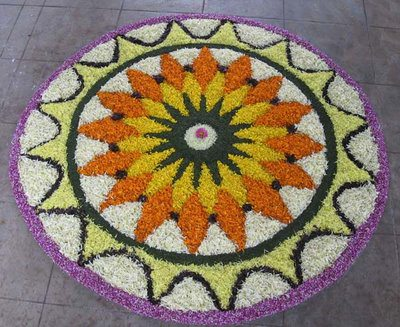
Athapookalam or Onapookalam is the flower bed or flower arrangements done during Onam celebrations in Kerala. The tradition of making Pookalam in front of the main entrance is very old and is followed by everyone who belongs to Kerala. Athapoo is usually circular in shape and multi-tiered colourful arrangements of flowers, petals and leaves. In Malayalam language, ‘Poo’ stands for ‘flower’ where as ‘Kalam’ stands for ‘artwork’. It is an intricate and very colourful arrangement of flowers which, when laid on the floor, gives an appearance of a carpet made purely of flowers. The floral carpet, known as ‘Onapookkalam, is made out of the gathered blossoms with several varieties of flowers of differing tints pinched up into little pieces. Diameter of a Pookalam normally ranges from four to five meters.
How is Pookalam Made
The concept of pookalam differ from place to place. In my side for making pookalam first of all the entire floor is cleaned and all the dust is wiped out. Cowdung is considered very holy and spread over the entire wiped area where the Pookalam is to be made. Cow dung has the power to kill bacteria which are harmful for humans and considered good for health.It is very rich in minerals and a great factor of anti-bacterial.It prevents people from various diseases and health issues.Small insects like scorpions, centipeded etc., don’t come near to the places which are coated with the paste of cow dung.Cow dung acts as a natural mosquito repellent.Mosquitoes stay away from such places.The floor which is coated with cow dung remains warm in winters and cold in summers.
Once the cow dung is evenly spread, motifs on it are made using the hairline bamboo sticks or any pin like material. Then the pattern made on the cowdung is filled with flowers. Starting from the Atham day, every day a ring of flowers and leaves is added to the pookalam making it grow in size till it reaches its final shape on Thiruvonam day. On the Atham day, there will only be a single ring, with single colour flower, the next day which is Chithira there will be two rings with two colours of flowers like that and finally on the Thiruonam day there will be ten rings with ten different colours of flowers. In some places, each nakshatram of the day used to be marked on the Pookalam as it stands as the representation of the Nakshatra.
FLOWERS USED FOR POOKKALAM:-
Traditionally pookalam included flowers endemic to Kerala and the Dashapushpam (10 flowers) i.e.
1) Valliuzhinja,(Cardiospermum halicacabum)
2) Thiruthali, ( Manthrogora Officianalum)
3) Muyalchevi(Oricheviyan,)
4) Nilappana,(Curculigo Orchiodes)
5) Mukkuti (Biophytum Sensitivum),
6) Karuka(Cynodon dactylon),
7) Kanjunni/Kayyonni(Eclipta alba),
8) Poovam Kurinnila(Vernonia cineria),
9) Cheroola(Ervalanata),
10) Vishnukraanthi/Krishnakraanthi(Ivolvulus Ulcinoides).
Dasa” means ten in sanskrit and pushpam means flowers. These ten herbs are traditionally significant to Keralites, and are used for decorative purposes, such as making the floral carpet Pookalam during festivals like Onam.Divine power of dasapushpam the ten sacred herbs flowers give a healthy mind body and soul having many curative properties. More than flowers the entire plant is considered in this group and is widely used in ayurveda. These herbs are found almost everywhere in Kerala and ealrier pookalam is made up of only with dasahapuspam.
Nowadays Various flowers are used to get the desired design and pattern. Commonly used flowers are Thumba, Thulasi, Kadali, Mukkutti, Chethi, Shankupushpam, Manthaaram, Jemanthi and Chembarathi , Rose, Marigold, Pichakam, pavizhamalli, nandyaarvattam, are some of the flowers using for making pookalam. Thumba flowers are considered best as they are small in size white in color and glitter in the rays of the sun which depicts purity and it manifests the presence of all colors – the complete energy of light. ‘Thumba Poo’ is also considered to be the favorite flower of Lord Shiva and King Mahabali was a devout worshiper of Shiva.
From a share by Shaija Bhaskaran
